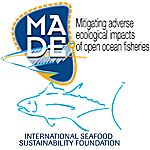In the southern Atlantic, many vulnerable shark species is caught as by-catch by tuna longline fleets. In this study, the spatial distribution of shark catch rates was predicted to identify the most sensitive areas, where the incidental catch is higher. Catch and effort data was collected by on-board observers of the National Observer Program that survey the Brazilian chartered tuna longline fleet. A total of 14,800 sets were recorded from 2004 to 2010 and analysed. The Brazilian longline effort was spread over a broad area in the equatorial and South Atlantic Ocean, with a higher concentration from 10ºN to 30ºS and from 20ºW to 40ºW. General additive models were used to predict the catch rates of 4 species that frequently occur within the operation area: the blue (BSH), mako (MAK), silky (FAL) and oceanic withetip (OCS) sharks. The catch per unit of effort (CPUE) of each species was used as the response variable. The factors trimester, strategy (that characterises the fishing operation), latitude and longitude were the explanatory variables. Due to the very low amount of data on MAK, the trimester factor was not considered. The models prediction shows changes in catch rates of BSH along the year being higher in the northern area in the first half of the year going south afterwards. Catch rates of MAK are low mainly in the south part of the fishing area. Catch rates of FAL and OCS are restricted spatially near the coast and seasonally (first half of the year).
- Presentation

 PDF version
PDF version
